 Front page > Software tutorial > I Changed These 10 Windows 11 Settings to Maximize My Laptop\'s Battery Life
Front page > Software tutorial > I Changed These 10 Windows 11 Settings to Maximize My Laptop\'s Battery Life
I Changed These 10 Windows 11 Settings to Maximize My Laptop\'s Battery Life
Laptop batteries degrade over time and lose their capacity, resulting in less uptime. I faced the same situation with my ASUS laptop, but after tweaking some deeper Windows 11 settings, I witnessed a massive improvement in battery life. I'll share them below.
1 Tweak Power Mode
Power mode in Windows 11 indicates your device's use of the available resources. Ideally, you must set it to Balanced or Maximum performance (if you have an AC adapter connected).
But these two modes won't help improve battery life. Navigate to Settings > Power & battery > Power mode. Select Best power efficiency from the dropdown to conserve your laptop's battery life.

2 Enable Battery Saver or Energy Saver
Battery Saver will force your Windows PC to stop background activities, updates, sync, and other OS elements that consume system resources and aggressively drain the battery.
Press Win A to open the Quick settings. Then click the Battery Saver icon to enable the feature. However, you can access more granular controls by following these steps:
- Go to Settings > System > Power & battery > Battery saver.
- Choose a battery percentage level option (10, 20, 30, 40, 50 percent, or Always) when the battery saver should auto-enable.
- Select the Lower screen brightness when using battery saver option to reduce the screen brightness to 20 percent.
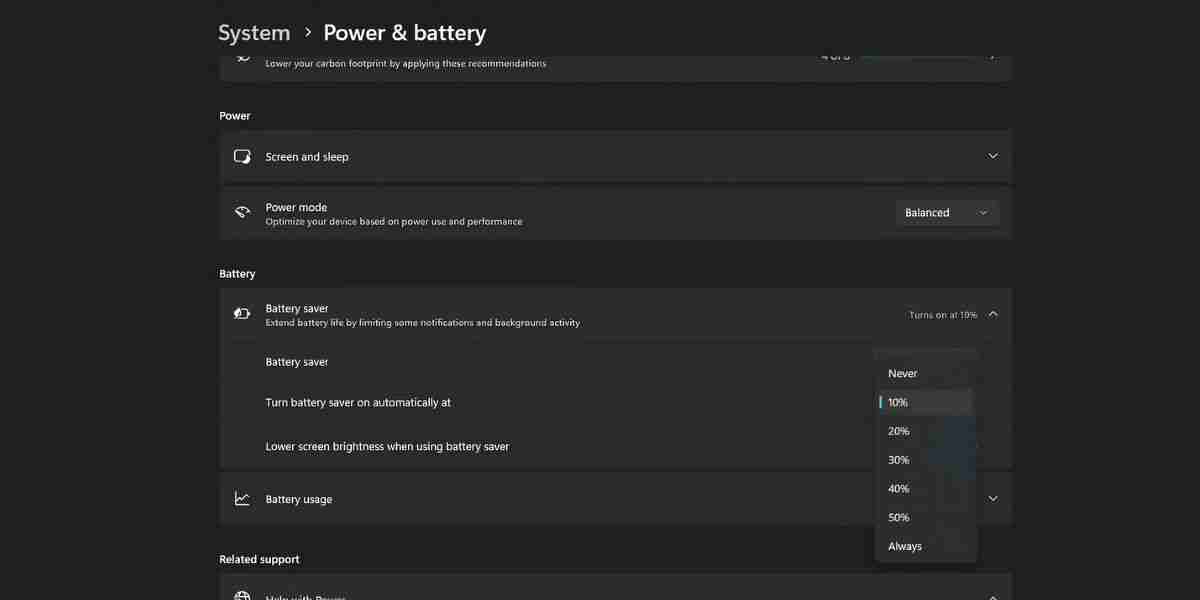
The 20 percent brightness level isn't applicable in every scenario (like outdoors). You can skip this option and set the brightness manually.
Microsoft rebranded Battery Saver to Energy Saver in Windows 11 24H2.
3 Lower the Display's Refresh Rate
High-refresh rate displays that are available on mid and high-end laptops consume more power. When battery life is a priority, you don't need the best visual experience the display can offer. It's better to lower the refresh rate by following these steps:
- Open the Start menu, type advanced display settings, and hit Enter.
- Click the dropdown next to Choose a refresh rate and select 60Hz.
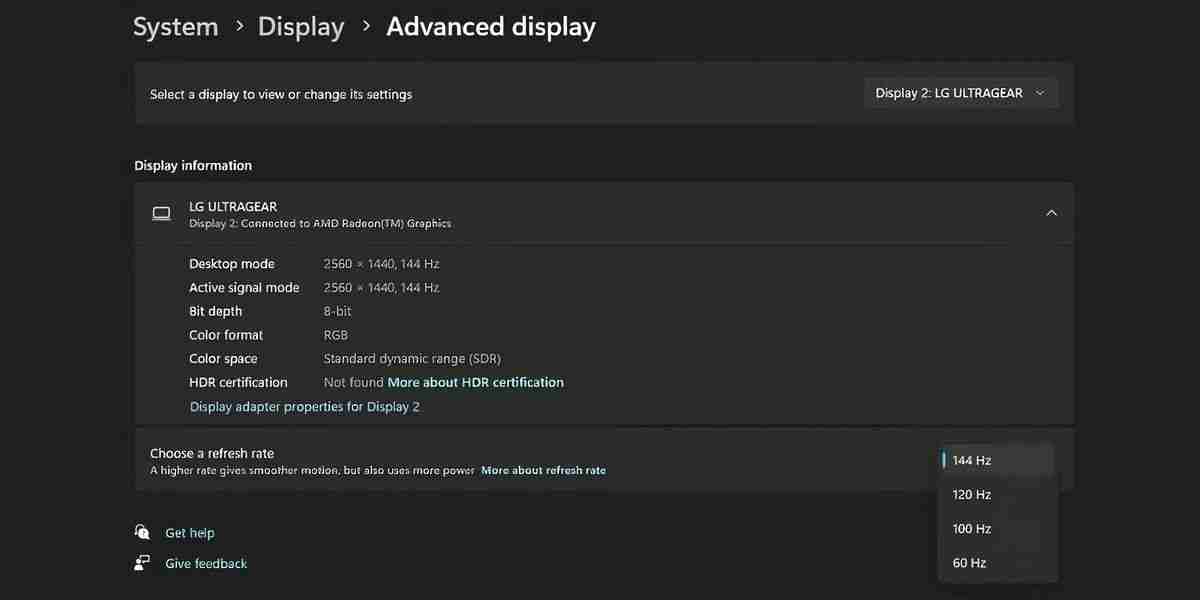
This small compromise in visual fidelity will help your Windows 11 laptop last longer.
Some OEMs bundle an app—for example, Armoury Crate on my Asus TUF laptop—which automatically lowers the refresh rate when using battery power. In such cases, you don't need to reduce the refresh rate manuallly.
4 Change Screen and Sleep Settings
Screen and sleep settings can help you save battery when you're not using your laptop (even briefly). You can define an interval after which the display powers off or the computer enters sleep mode by following these steps:
- Press Win I to open the Settings app and head to System > Power & battery > Screen and sleep section.
- Pick an appropriate duration (3 or 5 minutes) for the On battery power, and turn off my screen after option.
- Select a time limit (5 minutes or more) for the On battery power, put my device to sleep after option.
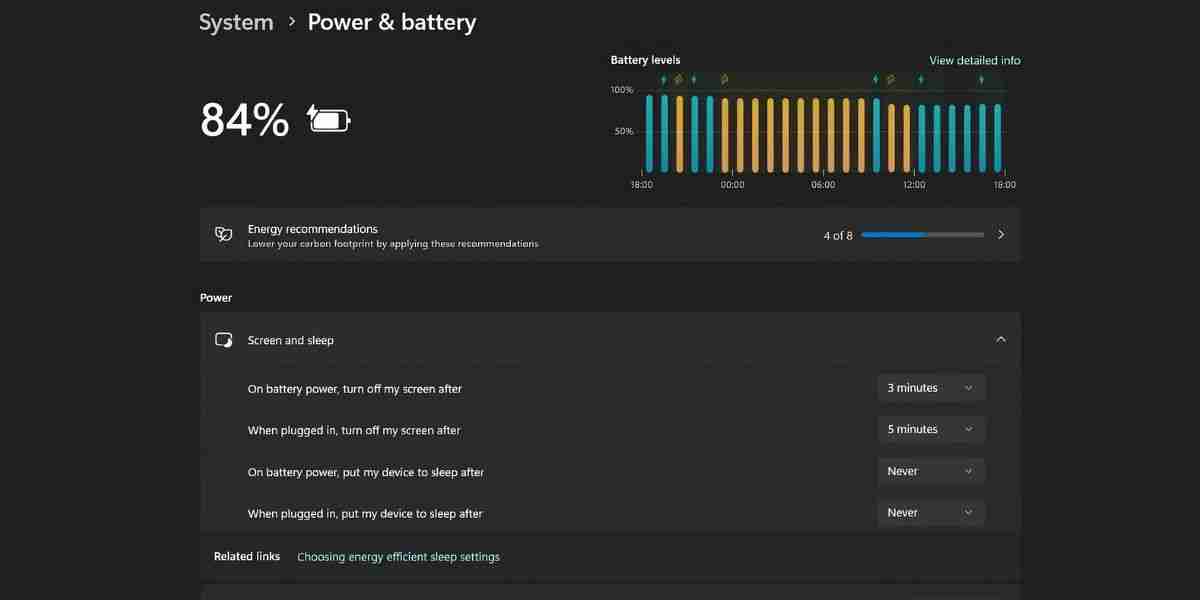
5 Disable Startup and Background Apps
Startup apps reduce battery life because they start running the moment you log in to your PC. To disable them, visit Settings > Apps > Startup section. Turn off the toggle next to apps that you don't need.

For example, you can disable game clients and collaboration apps like Microsoft Teams, third-party apps, etc. Don't turn off the touchpad or display apps.
While Battery Saver takes care of background apps to some extent, Microsoft states that some apps or their features (notifications or updates) continue to run in the background. To turn these off, you must first identify the power hogs.
Remember that only some apps have an Advanced Options page that lets you change the background permissions. You can follow these steps for those apsp:
- Type Power & battery in the taskbar search box and press Enter.
- Click the View detailed report option.
- Then, click the ellipsis icon and select Manage background activity.
- Go to the Background apps permissions section and select the Never option.
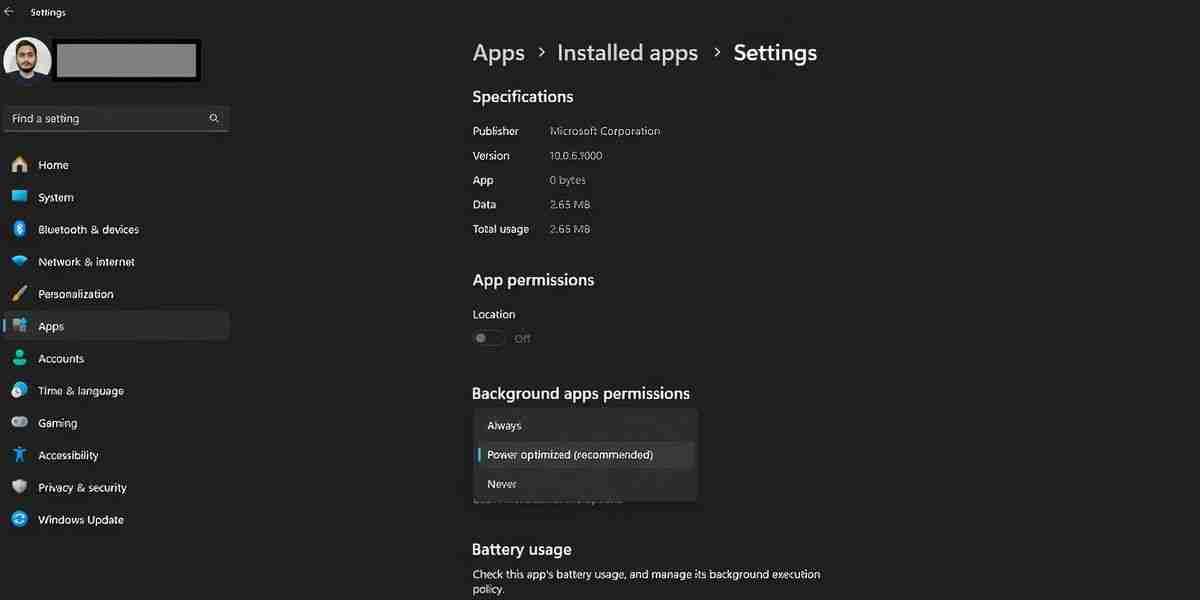
Now, the app won't run in the background, and you won't get any notifications.
6 Modify Video Playback Settings
You can lower video playback settings in Windows 11 to boost battery life. Go to Settings > Apps > Video playback and set Battery options to Optimize for battery life.

If your laptop has an HDR display, Windows will turn the feature off on battery power. However, if it doesn't have an HDR display and you use the HDR streaming option, you must configure it. Here's how:
- Open the Settings app and navigate to System > Display > HDR.
- Set Battery options to Optimize for battery life.
- Disable the HDR video streaming option for maximum savings if you don't need it.

7 Configure Graphics Settings for Apps
If your laptop has a dedicated GPU, you can force the apps to use the integrated GPU (part of the CPU) to save power. Here's how:
- Search for graphics settings in the taskbar search box and press Enter.
- Click on any app on the page to reveal the additional settings.
- Click Options, select Power saving, and hit Save.
- You might have to restart the app to apply the changes.
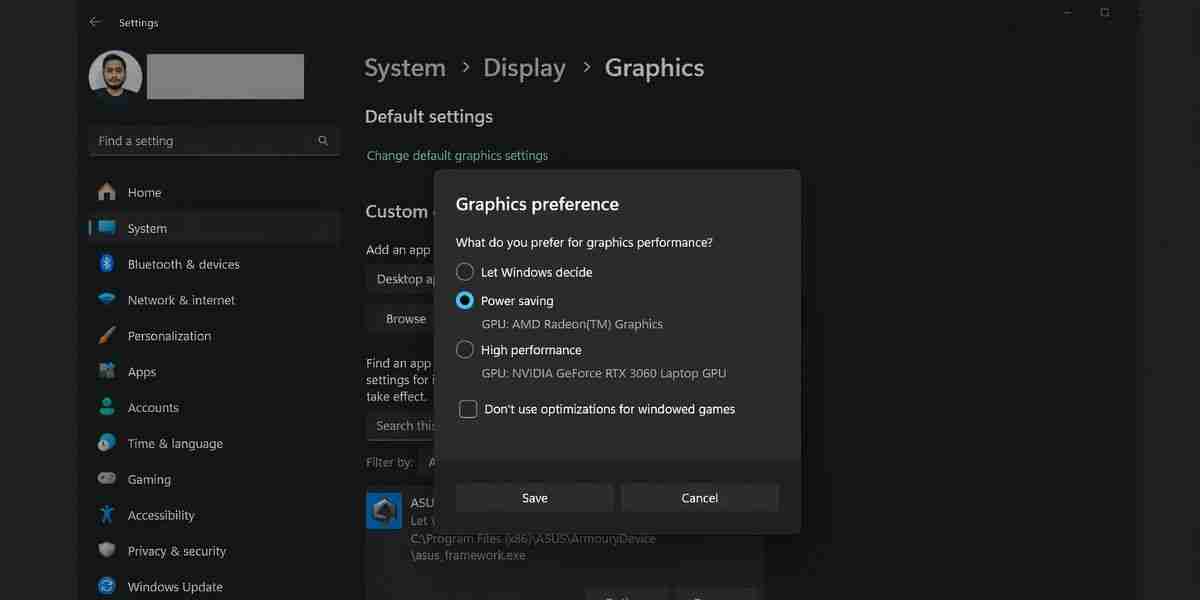
8 Adjust Windows Search Indexing Settings
Windows builds a search index in the background to help you find items faster. But you can force the Indexing feature to take a backseat while using battery power. Here's what you need to do:
- Press Win S, type Windows Search settings, and hit Enter.
- Enable the toggle next to Respect power settings when indexing.
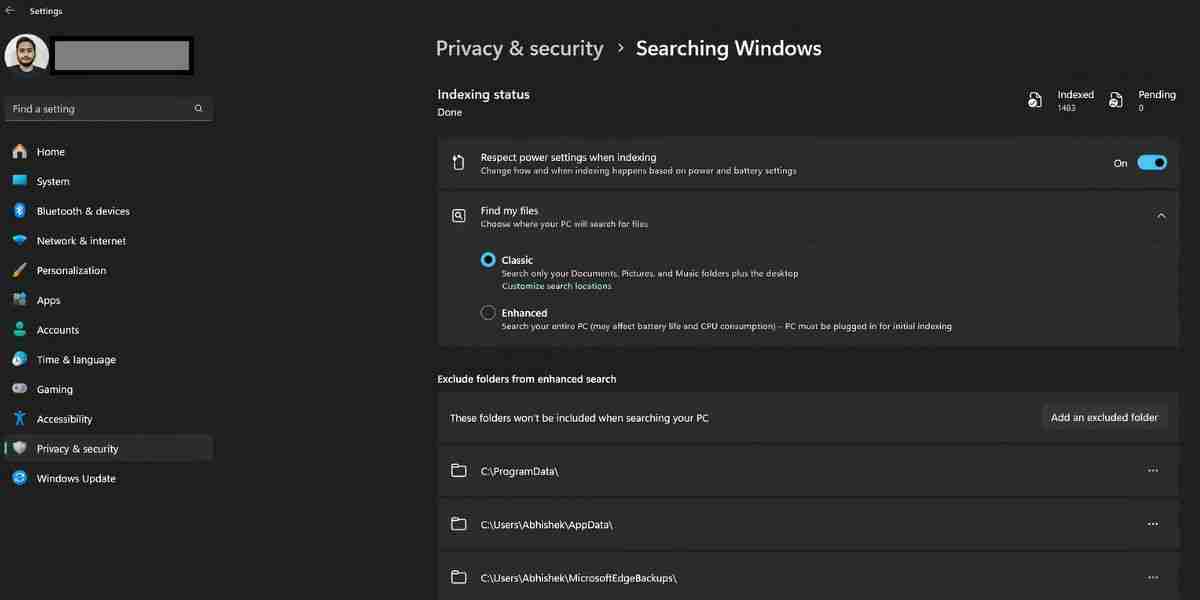
9 Use Power Saving Mode in Browsers
Browsers are indispensable tools for most productivity tasks you do online. Be it reading or editing documents, researching, conducting virtual meetings, etc. But browsers consume a lot of power and memory while doing so.
However, Edge and other popular browsers have power-saving features that can extend your laptop's battery life. Edge is a fantastic choice for saving power on Windows laptops due to its efficiency mode and sleeping tabs feature.
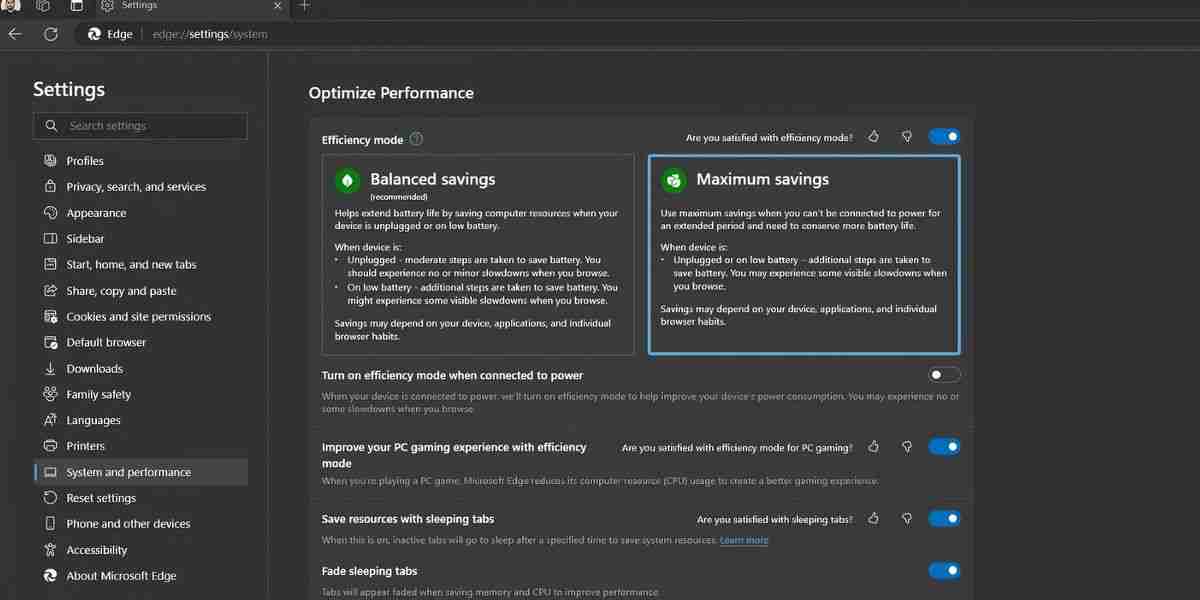
Similarly, Chrome has a built-in Energy Saver mode that lowers the background activity and visual effects. All these features will force the browser to gulp less battery.
10 Experiment With a Custom Power Plan
You can create a custom power plan in Windows 11 that adheres to your battery-saving requirements. By doing so, you can control the processor power management, display and sleep settings, wireless adapter settings, and more. However, you'll have to do a lot of tinkering to understand what settings work for your use case.
It's a bit complex to set up and is useful only if you want to leave no stone unturned to maximize battery life on your laptop. You can also check the battery report on Windows to understand your laptop's battery capacity and whether it needs replacement.
Overall, with these settings tweaks, you should be able to get your Windows laptop to last much longer on battery power. But if none of these tips made a noticeable impact, it's probably time to replace the battery or upgrade your laptop altogether.
-
 How to delete your data from a person search siteThis article was last updated on February 24, 2025. Many people are unaware that a significant amount of their personal data is readily accessible on...Software tutorial Posted on 2025-04-21
How to delete your data from a person search siteThis article was last updated on February 24, 2025. Many people are unaware that a significant amount of their personal data is readily accessible on...Software tutorial Posted on 2025-04-21 -
 How to disguise an iPad as a laptopThis updated article (originally published October 31, 2019) explores how to transform your iPad into a laptop alternative using iPadOS 16 beta featur...Software tutorial Posted on 2025-04-21
How to disguise an iPad as a laptopThis updated article (originally published October 31, 2019) explores how to transform your iPad into a laptop alternative using iPadOS 16 beta featur...Software tutorial Posted on 2025-04-21 -
 How to clean Mac mailbox cache? How to delete it on Mac?This guide explains how to clear the Mail cache on your Mac, addressing common issues like slow performance and email loading problems. The macOS Mai...Software tutorial Posted on 2025-04-21
How to clean Mac mailbox cache? How to delete it on Mac?This guide explains how to clear the Mail cache on your Mac, addressing common issues like slow performance and email loading problems. The macOS Mai...Software tutorial Posted on 2025-04-21 -
 How to prioritize the allocation of WiFi to the most needed devicesModern homes usually have multiple devices connected to Wi-Fi access networks simultaneously, which often leads to bandwidth tightness, especially w...Software tutorial Posted on 2025-04-19
How to prioritize the allocation of WiFi to the most needed devicesModern homes usually have multiple devices connected to Wi-Fi access networks simultaneously, which often leads to bandwidth tightness, especially w...Software tutorial Posted on 2025-04-19 -
 McAfee antivirus software review: Is it enough? 【Function, Price】McAfee: A Veteran Antivirus, But Is It the Best for Macs? McAfee, a long-standing and reputable name in cybersecurity, offers a robust antivirus suite...Software tutorial Posted on 2025-04-19
McAfee antivirus software review: Is it enough? 【Function, Price】McAfee: A Veteran Antivirus, But Is It the Best for Macs? McAfee, a long-standing and reputable name in cybersecurity, offers a robust antivirus suite...Software tutorial Posted on 2025-04-19 -
 OnePlus Watch 3 is postponed to April due to funny issuesAfter the long-awaited OnePlus Watch 3 smartwatch is released, the purchase plan may require a slight adjustment. A ridiculous production problem has...Software tutorial Posted on 2025-04-19
OnePlus Watch 3 is postponed to April due to funny issuesAfter the long-awaited OnePlus Watch 3 smartwatch is released, the purchase plan may require a slight adjustment. A ridiculous production problem has...Software tutorial Posted on 2025-04-19 -
 Tips to make the most of the tap function on the back of your iPhoneOver the years, Apple has developed a large number of tools to make using iPhones more convenient. Although the "Tap Back" feature is dull,...Software tutorial Posted on 2025-04-18
Tips to make the most of the tap function on the back of your iPhoneOver the years, Apple has developed a large number of tools to make using iPhones more convenient. Although the "Tap Back" feature is dull,...Software tutorial Posted on 2025-04-18 -
 Quickly get Windows 11 24H2 updates, skip the waiting queueIn the comprehensive guide, MiniTool will walk you through how to bypass Windows 11 24H2 waiting line using Group Policy and Registry. Take action if ...Software tutorial Posted on 2025-04-18
Quickly get Windows 11 24H2 updates, skip the waiting queueIn the comprehensive guide, MiniTool will walk you through how to bypass Windows 11 24H2 waiting line using Group Policy and Registry. Take action if ...Software tutorial Posted on 2025-04-18 -
 Tips for using mobile phone hotspots: How to avoid the surge in data trafficUsing your phone as a hotspot for your laptop on the go is convenient, but laptops are data hogs. Unlike phones, which prioritize Wi-Fi for tasks like...Software tutorial Posted on 2025-04-18
Tips for using mobile phone hotspots: How to avoid the surge in data trafficUsing your phone as a hotspot for your laptop on the go is convenient, but laptops are data hogs. Unlike phones, which prioritize Wi-Fi for tasks like...Software tutorial Posted on 2025-04-18 -
 Which one is better compared to iPhone and Android?Choosing between iOS and Android: A Detailed Comparison The mobile phone market is dominated by two major players: iOS and Android. Both boast millio...Software tutorial Posted on 2025-04-17
Which one is better compared to iPhone and Android?Choosing between iOS and Android: A Detailed Comparison The mobile phone market is dominated by two major players: iOS and Android. Both boast millio...Software tutorial Posted on 2025-04-17 -
 Safari slows down on Mac? The secret to speeding up safari!Safari browser runs slowly? A must-see guide to acceleration for Mac users! Safari is one of the fastest browsers on Mac, but it is also not complete...Software tutorial Posted on 2025-04-17
Safari slows down on Mac? The secret to speeding up safari!Safari browser runs slowly? A must-see guide to acceleration for Mac users! Safari is one of the fastest browsers on Mac, but it is also not complete...Software tutorial Posted on 2025-04-17 -
 I thought I would never need a wallet until this happenedYou’re in a nice restaurant with your beloved; perhaps both of you are enjoying a lovely steak. After a while, you raise your hand and ask the waiter ...Software tutorial Posted on 2025-04-17
I thought I would never need a wallet until this happenedYou’re in a nice restaurant with your beloved; perhaps both of you are enjoying a lovely steak. After a while, you raise your hand and ask the waiter ...Software tutorial Posted on 2025-04-17 -
 Comparison between McAfee and MacKeeper: Which one is better? How to choose antivirus software?Choosing the right cybersecurity solution for your Mac can be tricky. This comparison of McAfee and MacKeeper helps you decide between a well-establi...Software tutorial Posted on 2025-04-17
Comparison between McAfee and MacKeeper: Which one is better? How to choose antivirus software?Choosing the right cybersecurity solution for your Mac can be tricky. This comparison of McAfee and MacKeeper helps you decide between a well-establi...Software tutorial Posted on 2025-04-17 -
 7 security communication apps you should useChoosing a messaging app often boils down to what your contacts use, overlooking a crucial factor: security. We share incredibly sensitive informatio...Software tutorial Posted on 2025-04-17
7 security communication apps you should useChoosing a messaging app often boils down to what your contacts use, overlooking a crucial factor: security. We share incredibly sensitive informatio...Software tutorial Posted on 2025-04-17 -
 The ultimate guide to how to label any websiteBeyond Static: Annotating Web Pages with Ease The web shouldn't be a static experience. With the right tools, you can actively engage with websit...Software tutorial Posted on 2025-04-17
The ultimate guide to how to label any websiteBeyond Static: Annotating Web Pages with Ease The web shouldn't be a static experience. With the right tools, you can actively engage with websit...Software tutorial Posted on 2025-04-17
Study Chinese
- 1 How do you say "walk" in Chinese? 走路 Chinese pronunciation, 走路 Chinese learning
- 2 How do you say "take a plane" in Chinese? 坐飞机 Chinese pronunciation, 坐飞机 Chinese learning
- 3 How do you say "take a train" in Chinese? 坐火车 Chinese pronunciation, 坐火车 Chinese learning
- 4 How do you say "take a bus" in Chinese? 坐车 Chinese pronunciation, 坐车 Chinese learning
- 5 How to say drive in Chinese? 开车 Chinese pronunciation, 开车 Chinese learning
- 6 How do you say swimming in Chinese? 游泳 Chinese pronunciation, 游泳 Chinese learning
- 7 How do you say ride a bicycle in Chinese? 骑自行车 Chinese pronunciation, 骑自行车 Chinese learning
- 8 How do you say hello in Chinese? 你好Chinese pronunciation, 你好Chinese learning
- 9 How do you say thank you in Chinese? 谢谢Chinese pronunciation, 谢谢Chinese learning
- 10 How to say goodbye in Chinese? 再见Chinese pronunciation, 再见Chinese learning
























